- Charles Frederick Cull
of Christmas Pie, Normandy
-
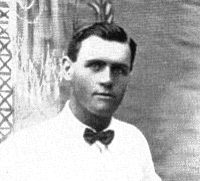
- A photo of Charles Frederick Cull as a young man, taken
in Ghana.
Known affectionately as "Charlie" to most people, Charles
Frederick Cull was a highly respected local builder in Normandy, Surrey,
but in his brief life he was verily "a man of many parts". Charlie
was born in London on March 22nd 1898 and like most men of his generation
was conscripted at age 18 years into Military service. He was drafted into
the Army and ironically, being a Londoner was placed in the Welsh Regiment,
serving in France as a signaler. Unfortunately, and as was the case with
most signalers having to signal with their arms above the parapets of the
trenches, was shot in the arm and returned to "Blighty" to convalesce
at a hospital in the Thornton Heath area where he met and later married
in 1920 Ellen Martin, born locally on the 7th November 1899. She worked
at various wartime jobs but never worked after she was married.
Following his medical release from the Army in September 1918 Charlie
enrolled for a Vocational Training Course at the Eat Ham Technical College,
studying Building and Construction eventually finding work with a small
non-Union Building Contractor. Within a few years they managed to buy their
first house in East Ham, which for a young couple in those hard times was
quite an achievement. As a young man Charlie showed the qualities of ambition
and determination for not only bettering himself but also owning his own
business. These qualities were epitomized between 1925 and 1927 when he
worked as a Civil Engineer for the General Engineering and Construction
Company (known as GECCO) on the Gold Coast (now Ghana). His drive was to
save sufficient money to start his own business.
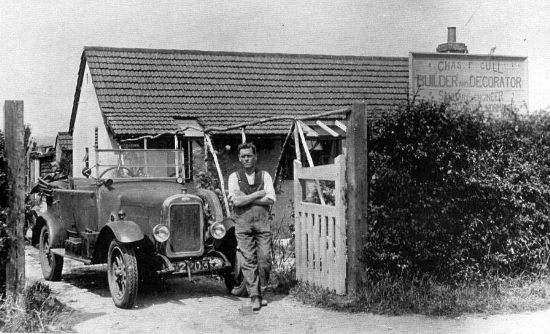
- This was taken soon after Charlie started in business, probably
around the late nineteen twenties. The car is a Clyno which he purchased
from the family who lived just around the corner from Christmas Pie on
the way up to the Hogs Back. The owner had obviously lost a lot of. money
as he committed suicide when the depression hit. The family were selling
off everything.
In 1928 the East Ham house was sold and the bungalow "Littledown",
Flexford Road was purchased together with the associated Building Business,
Goodwill, Yard and five acres of land. By then the effects of "The
Depression" throughout the country were being felt also in the countryside
and work within the building business was slowing, so when he war offered
another contract to go back to the Gold Coast in 1930 he accepted with
the intention of going for at least another two years. Unfortunately the
depression deepened and GECCO withdrew the offer of a contract. Charles
was obliged to slowly build up the business in Normandy carrying out repairs,
and building the occasional bungalow. As the economy improved so the business
prospered.
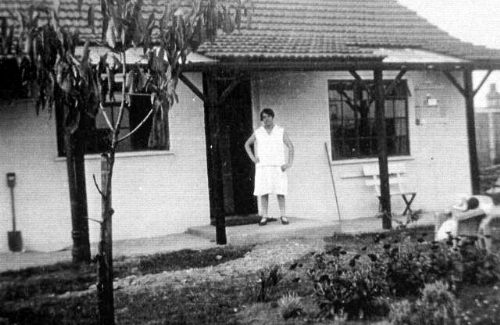
- This is a photo of "Littledown" with Ellen Cull
From being an overseas civil engineer, constructing million-pound works
abroad, Charlie found doing small building jobs was somewhat frustrating
until Bill Olley of Glaziers Lane suggested building an estate of bungalows.
One night Charlie and Bill sat down and sketched a plan of the proposed
estate. Charlie was a good draughtsman and Bill a good businessman. Subsequently,
in the late 1930s, Charlie bought land in Normandy at Christmas Pie and
Flexford that had been occupied previously by chicken farms and small orchards
and began to build a housing estate.
To start the development Charlie created an access from Flexford Road
through the side garden of a property (then in Flexford Road but now 2
Christmas Pie Avenue). The new road was firstly named Flexford Close but
much later was renamed Christmas Pie Avenue. To ensure adequate width for
the new road, the west end part of the property was carefully removed and
the front door, previously facing Flexford Road, was reinstalled in the
newly constructed rear of the dwelling but now opening onto the new road
Flexford Close. In about 1933 the present "Yeolan" in Flexford
Road, was subsequently built in the front garden of that property.
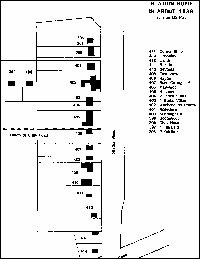 |
Map of Station Road c.1939.
Click on map to see an enlargement |
The proximity of Wanborough Station, with its easy rail access to Guildford
(and hence London), Reading and Redhill made these new properties an attractive
purchase proposition to people referred to today as "commuters".
To provide an alternative access to the rapidly developing estate, "Maywood"
in Station Road (now named Glaziers Lane) was demolished and the recovered
land together with part of the garden of "Rose Cottage" was used
for the construction of a new road. The newly constructed road was subsequently
named Culls Road thus commemorating and perpetuating Charlie's name.
Behind their bungalow "Littledown", Charlie had improved the
builder's yard, joinery shop, glazing shop and paint shop to accommodate
a workforce that varied from 25 to 60. His business office was a purpose
built extension to the right-hand-side of their bungalow, accessed off
the track to the workshops and store buildings. Soon Charlie was selling
the bungalows before he'd finished building them and at £500 each
he would have a dwelling ready to move into within 12 weeks. Development
slowed as the country entered 1939.
At the start of the Second World War, Charlie's business like many small
businesses faltered and others collapsed as materials were diverted to
the war effort. In addition most of his employees were called-up for Military
Service, an experience he knew only too well. However he was able to get
supplies to build Air Raid Shelters and was subsequently included on the
list of approved contractors for the War Department Contracts, one of which
was to build the BBC blockhouse in Culls Road near its junction Christmaspie
Avenue and where Richard Dimbleby, the BBC Commentator, made his historical
broadcast announcing the invasion of Europe by Allied Forces, the occasion
commemorated by a plaque. The first Air Raid Shelter was built in Charlie's
own garden and another in "Downton", Green Lane East, then called
Christmas Pie Road, the home of the Edwards family.
Charlie joined the Home Guard and spent many nights "Guarding the
Home Front". In those early days there was the occasional false alarm
but on one memorable night (not to be easily forgotten by the family),
someone at the Aldershot Military Command mistakenly pressed the button
for "Invader Alert". Canon Tapsfield, the Vicar at St Mark's
Wyke rushed into the church in his pyjamas and hung on to the Church Bell
for what seemed like forever. Charlie donned his Home Guard Uniform, his
daughter Nellie donned her Red Cross uniform the family said their tearful
goodbyes and departed into the night, thinking that they might never meet
again, only to be reunited the next morning!
Charlie and Ellen had two children namely Nellie Susan and Gordon, both
of whom attended the local Wanborough School between 1928 and 1934 and
Gordon to 1937, both often walking to school with the Head Teacher, who
lived nearby. During WWII Nellie (but preferred to be called Susan), served
in the Woman’s Auxiliary Air Force from 1941, where she met Joseph
Griffith, a Canadian who had enlisted in the RAF at the outbreak of the
war, and later married at St Mark’s, Church Wyke, then an (Airline
Navigator), of Manitoba Canada on the 25th October 1947.
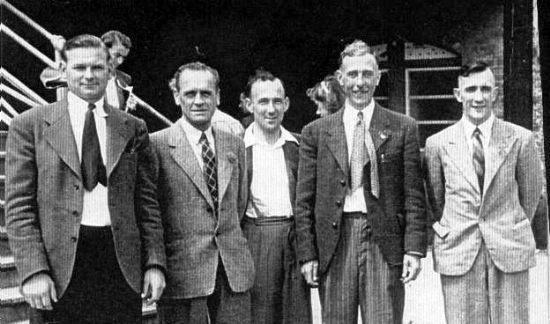
- Taken when Charlie Cull took all his employees for an outing
to the Coast. A common -practice in the nineteen-thirties, interrupted
by the war, but resumed afterwards - date approximately 1950. Charlie is
second from the left. The first on the left is Georgie Beer also from a
Normandy family who lived down Station Road. He was Deaf and Dumb and my
Father employed him as a Carpenter and general Handyman.
With the cessation of hostilities Charlie continued to build bungalows
in Flexford Close. He drove everywhere in a van on which was the slogan
"There goes Cull of Christmas Pie". Always the business man at
heart, Charlie constructed tennis courts behind the bungalow that were
available for hire at one shilling per hour but as local interest in the
use of the courts waned he converted them into a model speedway track on
which the cars, attached by a wire to a central post, attained speeds of
up to 74.5mph. Charlie was aided and abetted in this enterprise by an engineer
C E Smith, then residing at "Gradatim", now known as "Applewood",
Flexford Road. That courts-cum-track area has since been developed to accommodate
four bungalows: Dalmally, Muskerry, Nutmegs and Yuletide
The News Chronicle of 1954 advertised a competition, the prize for which
was a bungalow valued at £2500, believed designed by Miss Judith
G Ledeboer. The competition was won by Jack and Kath Bryant and Charlie
was chosen to build the bungalow that was later named "Karenza"
by Jack and Kath, now 27 Culls Road, Normandy
Shortly thereafter, Charlie purchased a pair of dilapidated farm cottages,
which he promptly restored, on the edge of Farnham Park and accessed off
a Right of Way to the Park. However, Ellen felt very isolated living there
and so in the 1950s Charlie built a house in West Street Selsey and named
it 'Christmas Pie House'. But regrettably Ellen, by now suffering with
Arthritis, persuaded Charlie to move away from the sea and to move back
to "Littledown", which they did, but sadly at age 60 years Charlie
died of a heart attack on the 10th June 1958.
- Following his death, Ellen endeavoured to manage the business but eventually
sold to a competitor (albeit a good friend of the family), C G Robertson
of Guildford and moved to Hambrook in Sussex where she stayed for several
years but finally moved to Tadley in Hampshire to be near her son Gordon
and his family. Ellen died at age 75 years in the Basingstoke Hospital
on the 7th September 1975.
P T Blakiston
|